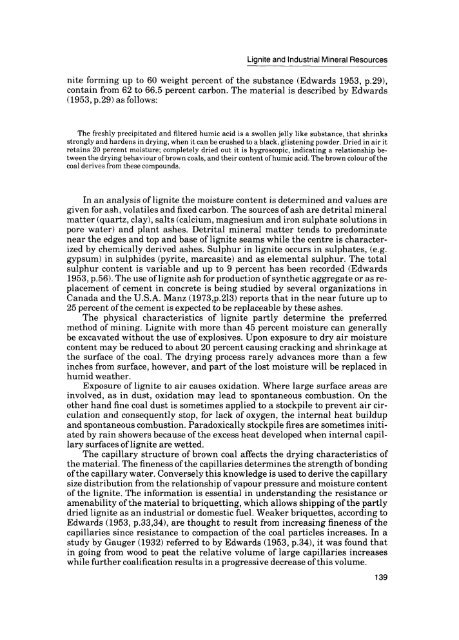Moose River Basin: geology and mineral potential - Geology Ontario
Moose River Basin: geology and mineral potential - Geology Ontario
Moose River Basin: geology and mineral potential - Geology Ontario
Create successful ePaper yourself
Turn your PDF publications into a flip-book with our unique Google optimized e-Paper software.
Lignite <strong>and</strong> Industrial Mineral Resources<br />
nite forming up to 60 weight percent of the substance (Edwards 1953, p.29),<br />
contain from 62 to 66.5 percent carbon. The material is described by Edwards<br />
(1953, p.29) as follows:<br />
The freshly precipitated <strong>and</strong> filtered humic acid is a swollen jelly like substance, that shrinks<br />
strongly <strong>and</strong> hardens in drying, when it can be crushed to a black, glistening powder. Dried in air it<br />
retains 20 percent moisture; completely dried out it is hygroscopic, indicating a relationship be<br />
tween the drying behaviour of brown coals, <strong>and</strong> their content of humic acid. The brown colour of the<br />
coal derives from these compounds.<br />
In an analysis of lignite the moisture content is determined <strong>and</strong> values are<br />
given for ash, volatiles <strong>and</strong> fixed carbon. The sources of ash are detrital <strong>mineral</strong><br />
matter (quartz, clay), salts (calcium, magnesium <strong>and</strong> iron sulphate solutions in<br />
pore water) <strong>and</strong> plant ashes. Detrital <strong>mineral</strong> matter tends to predominate<br />
near the edges <strong>and</strong> top <strong>and</strong> base of lignite seams while the centre is character<br />
ized by chemically derived ashes. Sulphur in lignite occurs in sulphates, (e.g.<br />
gypsum) in sulphides (pyrite, marcasite) <strong>and</strong> as elemental sulphur. The total<br />
sulphur content is variable <strong>and</strong> up to 9 percent has been recorded (Edwards<br />
1953, p.56). The use of lignite ash for production of synthetic aggregate or as re<br />
placement of cement in concrete is being studied by several organizations in<br />
Canada <strong>and</strong> the U.S.A. Manz (1973,p.213) reports that in the near future up to<br />
25 percent of the cement is expected to be replaceable by these ashes.<br />
The physical characteristics of lignite partly determine the preferred<br />
method of mining. Lignite with more than 45 percent moisture can generally<br />
be excavated without the use of explosives. Upon exposure to dry air moisture<br />
content may be reduced to about 20 percent causing cracking <strong>and</strong> shrinkage at<br />
the surface of the coal. The drying process rarely advances more than a few<br />
inches from surface, however, <strong>and</strong> part of the lost moisture will be replaced in<br />
humid weather.<br />
Exposure of lignite to air causes oxidation. Where large surface areas are<br />
involved, as in dust, oxidation may lead to spontaneous combustion. On the<br />
other h<strong>and</strong> fine coal dust is sometimes applied to a stockpile to prevent air cir<br />
culation <strong>and</strong> consequently stop, for lack of oxygen, the internal heat buildup<br />
<strong>and</strong> spontaneous combustion. Paradoxically stockpile fires are sometimes initi<br />
ated by rain showers because of the excess heat developed when internal capil<br />
lary surfaces of lignite are wetted.<br />
The capillary structure of brown coal affects the drying characteristics of<br />
the material. The fineness of the capillaries determines the strength of bonding<br />
of the capillary water. Conversely this knowledge is used to derive the capillary<br />
size distribution from the relationship of vapour pressure <strong>and</strong> moisture content<br />
of the lignite. The information is essential in underst<strong>and</strong>ing the resistance or<br />
amenability of the material to briquetting, which allows shipping of the partly<br />
dried lignite as an industrial or domestic fuel. Weaker briquettes, according to<br />
Edwards (1953, p.33,34), are thought to result from increasing fineness of the<br />
capillaries since resistance to compaction of the coal particles increases. In a<br />
study by Gauger (1932) referred to by Edwards (1953, p.34), it was found that<br />
in going from wood to peat the relative volume of large capillaries increases<br />
while further coalification results in a progressive decrease of this volume.<br />
139

















